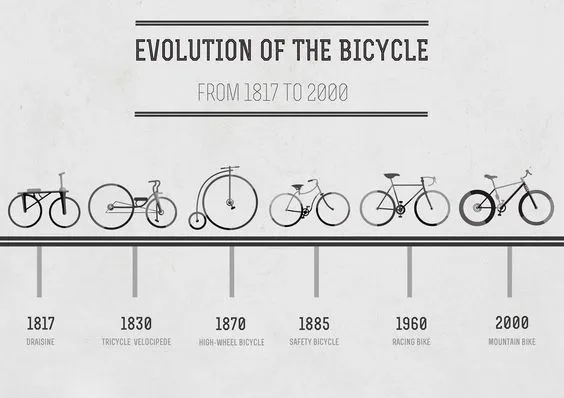Hi everyone! I guess a lot of us have or have had a bicycle at a certain moment. I do remember even crushing one of my teeth when I was little with my BMX bike. So, I was wondering how did bicycles look like back in time. and how they had later evolved.
DRAISINE (1817)
The draisine or velocipede, also nicknamed ’’hobby-horse’’ or ’’dandy horse’’, was the first successful human-propelled machine on the market, having two wheels and being steerable.
His basic characteristics were the following:
- 22 kilos weight (48 pounds)
- almost entirely of wood
- brass bushings within the wheel bearings
- iron-shod wheels
- a rear-wheel brake
- 152 mm of trail (6 inches) for a self-centering caster effect
TRICYCLE VELOCIPEDE (1830)
New human-propelled machines came later on in the format of three (tricycles) or four (quadracycles) wheels in various designs.
The velocipedes had several features:
- the use of pedals, treadles, and hand-cranks
- safer
- resistant-designs to high weight and high rolling.
HIGH-WHEEL BICYCLE (1870)
The high-wheel bicycle, also nick-named ’’penny-farthing” (penny – the front wheel, smaller in size and value; farthing – the rear) had an interesting design:
- the front wheel enlarging to enable higher speeds
- the rear wheel shrinking
- the frame being made lighter
However, this type of bicycle had several disadvantages: - the speed of the machine was limited by the inside leg measurement of the rider; in case of falling the rider’s legs could easily be caught underneath the handlebars
- the rider was high up in the air and traveling at a great speed, which made it unsafe, the danger of being injured or even killed being quite common
SAFETY BICYCLE (1885)
There were many attempts to design a safe bicycle. The first successful safety bicycle was the ''Rover'' produced by John Kemp Starley.
Its main features were:
- a steerable front wheel that had significant caster
- equally sized wheels
- a chain drive to the rear wheel
It managed to replace the high-wheeler by 1890, which was used at a large scale in North America and Western Europe.
RACING BIKE (1960)
The racing bike also called sports model, sport/ tourers, or ten-speed was long used by racers and serious cyclists.
Its main features were:
- dropped handlebars
- narrow tires
- derailleur gears
- 5-10 speeds
- a narrow ’’racing’’ type saddle
Speaking of BMX bikes at the beginning of my post, they were originated in California in the early 1970s (16-24 inch wheels) when teenagers used to imitate their motocross heroes on their bicycles.
MOUNTAIN BIKE (2000)
Mountain bikes appeared starting from 1981 and had far surpassed the sales of racing, sport/ racer, and touring bicycles by 2000.
Their main characteristics were:
- sturdier frames
- wider tires with large knobs for increased traction
- a more upright seating position (better visibility and shifting if bodyweight)
- various front and rear suspension designs
21st CENTURY
The 21st century was also the century of hybrid and commuter bicycles, also known as city bikes, cross bikes, or commuter bikes. Hybrid and commuter bicycles vary from fast and light racing-type bicycles with flat bars and other minimal adjustments to casual use to wider-tired bikes designed mainly for comfort, load-carrying, and greater mobility over a variety of road surfaces. Hub gears have become fashionable again – now with up to 8, 11, or 14 gears – given their improved technology and ease of maintenance.
I found it interesting how things had changed in the bicycle field and the continuous efforts to adjust the users' needs. If you just think of those early bicycle machines that you would barely use right now to new and more advanced bicycle technology, it definitely makes a change. Hope you enjoyed my post and maybe go for a ride with your bicycle if possible.
To write this post, I have also consulted this site right here
Best!
Maylena

